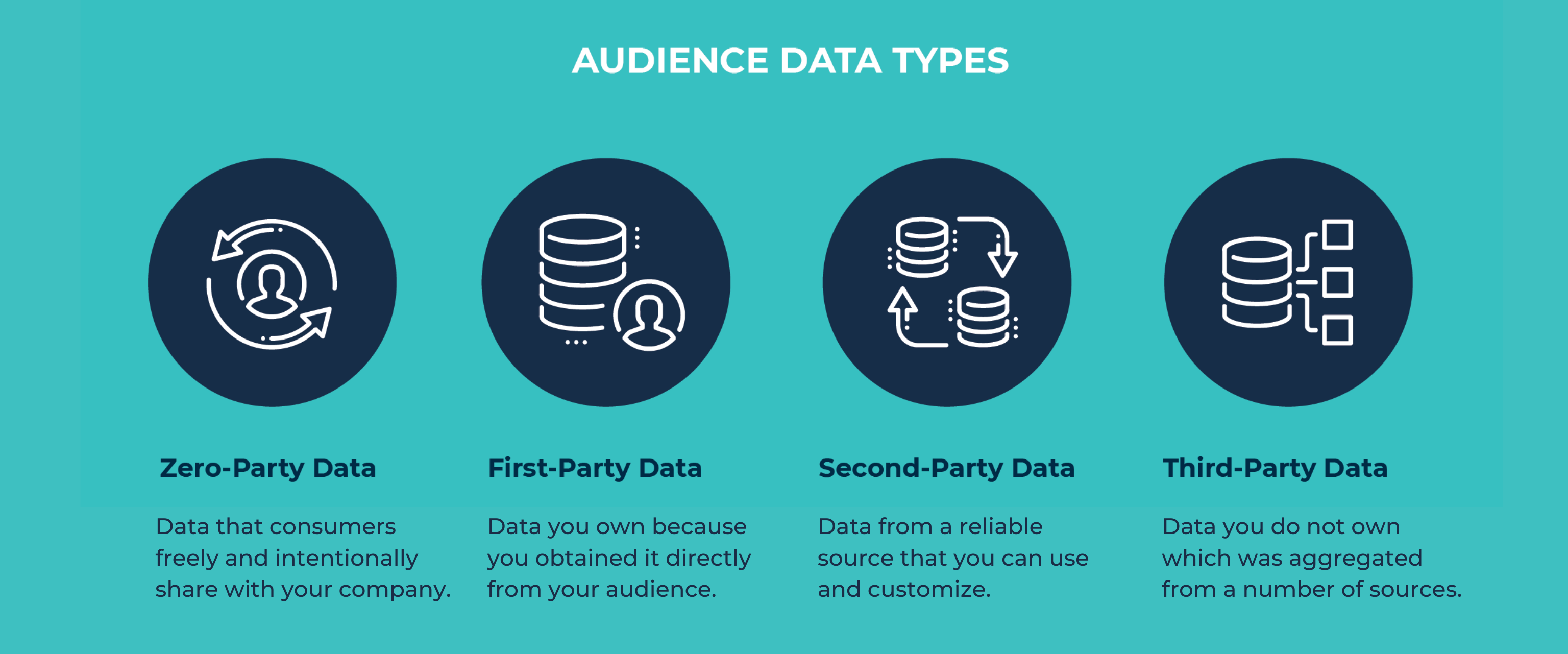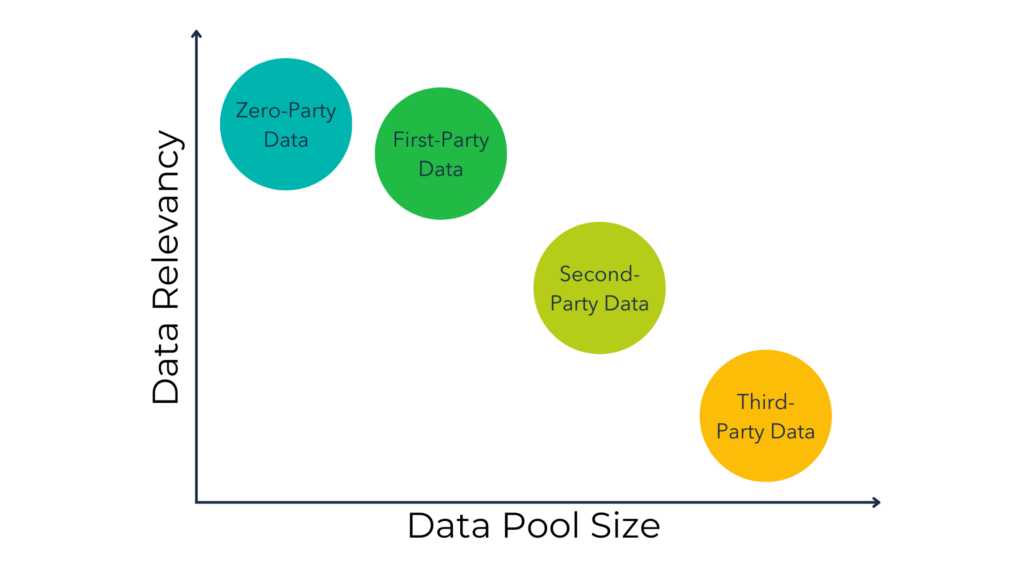All the data parties (zero-party, first-party, second-party and third-party) explained with examples
Last updated: September 26, 2023

You’ve heard of first-party data, but how does that relate to second-party data? And what is zero-party data? Why is third-party data not recommended? In this post, we’ll dive into the key characteristics of each audience data type and how they relate to each other.
Zero-Party Data
Zero-party data is data a customer intentionally and proactively shares with a brand – think filling out a profile and preferences on a website. This also includes subsequent data augmentation like progressive profiling. This kind of data is extremely valuable because this is accurate data supplied straight from the source.
Zero-party data is great because when you encourage individuals to freely provide information and validate their intent, you’re overcoming a big privacy barrier. When audiences willingly offer up their data, you can feel good about using it to personalize their experience and know that it’s exactly what they’re after.
Streamline your tech stack: Boost efficiency, unify data & retain talent! Get expert tips now:
Zero-party data is data an individual intentionally shares, like a first name and email when signing up for a newsletter.
Example: Cat enthusiast Dr. Kaitlin Warbler creates a profile on the premier pet website, Pet News Today. She includes her first and last name, email, home address and payment details to receive the monthly magazine. Not only that, but she also selects her newsletter preference – the weekly cat newsletter, of course. This is all considered Pet News Today’s zero-party data because Dr. Warbler intentionally and proactively shared this data.
While browsing, Dr. Warbler receives a pop-up asking what kind of pet she has. She selects “cat” from the dropdown. Now, Pet News Today has solid profile information gathered from progressive profiling and can use this additional zero-party data to deliver relevant sponsored campaigns to Dr. Warbler.
First-Party Data
You might be wondering how to distinguish zero-party data from first-party data. First-party data is data collected first-hand, but in a more passive manner compared to zero-party data (remember the key words “proactive” and “intentional” when thinking of zero-party).
First-party data encompasses both an individual’s zero-party data, like email address when signing up for a newsletter, as well as behaviors on your website, including app activities and on-page actions. It also includes clicks and other behaviors (i.e. hovering, scrolling and active time spent), session context, and how an audience member engages with personalized experiences.
First-party data also holds demographic information (IP address, first name, email, etc.) and ties it to the onsite click and view behaviors. With 1st party data, you glean valuable indicators into an individual’s interests and intent. Transactional data, such as purchases and downloads, is also considered first-party data.
First-party data includes zero-party data, as well as that person’s web behaviors (clicks and views), plus demographics like IP address.
Example: Revisiting Dr. Warbler from our previous example, from her zero-party data we know where she lives, that she’s (very) interested in cats, and she has a doctorate. Now we can layer in first-party data. She visits a few Pet News Today articles related to adopting cats, and then via a related article reads about advancements in cat food. She sees an announcement about Pet News Today’s expo later that month, and she registers for a VIP pass. Her first-party data – all passively collected – now includes 3 page visits tagged as “cats” as well as an event registration.
Second-Party Data
Second-party data is data that is acquired from a single known provider (such as another publisher). Essentially, second-party data can be described as first-party data owned by another company. While buying data from a trusted source sounds appealing, sharing data between companies can get murky, which is just one reason why first-party data is superior.
2nd party data, when used judiciously, can be a great source to expand your audience. Be wary of privacy implications, however.
Second-party data is another organization’s first-party data. This is typically purchased as part of an advertising agreement.
Example: Pet News Today partners with a local animal shelter for their upcoming expo. The animal shelter shares a list of recent donors, and Pet News Today offers these donors a discount to the expo. Pet News Today can call this list of donors second-party data.
Third-Party Data
Let’s now review the outermost bubble of audience data types: third-party data. Third-party data is any data that’s been collected by a business or other entity that doesn’t have any direct link to the visitor or customer. 3rd party data often comes from a variety of sources across the web, which is then segmented and sold (e.g. data purchased from exchanges like Lotame).
The downsides of 3rd party data? It’s often unreliable and can dirty up a database, leading to lack of audience trust. It can also impact engagement rates and sender reputation, both of which can be detrimental to your business.
Plus, it’s important to note that third-party audiences have no direct connection to your brand, so any outreach must be specific and deliberate.
Third-party data is data from a variety of different sources sold or collected by a data bank and collated with data from other sources, like publicly available information. This data is resold or licensed on exchanges or social networks.
Example: Pet News Today tries to expand their email list by running a campaign using data tagged as “pet lovers” from an exchange. This data is stitched together from several sources, including purchase information from a credit card company, email database records from pet suppliers, and demographic information.
Pet News Today realizes this dataset includes a lot of non-relevant individuals, including people who have purchased presents for their friends’ pets or people who don’t own any pets themselves but simply interact with pet-focused media. It also matched individuals who had similar behaviors or demographic details – including individuals who lived in the same apartment complex as previous pet owners.

So what’s best?
Audience development professionals know that focusing on growing zero- and 1st party data is hard, but is ultimately the healthiest strategy to protect against the disappearance of the third-party cookie.
2nd-party data can be useful, particularly when the source has an audience that is closely aligned with your ideal customer or member.
3rd-party data is attractive because of the sheer amount of data that can be available, but with the diametric risk of dirty data.
Organizations should determine what balance to strike between audience size + reach and data accuracy + relevancy. From there, they should optimize their audience acquisition and engagement against that metric.
Omeda has in-house experts to help guide your first-party growth strategy. Reach out to your CSM, or if you’re new to Omeda, you can request a consult here.
To learn more about the value of first-party data, read our playbook here.
Subscribe to our newsletter
Sign up to get our latest articles sent directly to your inbox.
What you should do now
- Schedule a Demo to see how Omeda can help your team.
- Read more Marketing Technology articles in our blog.
- If you know someone who’d enjoy this article, share it with them via Facebook, Twitter, LinkedIn, or email.